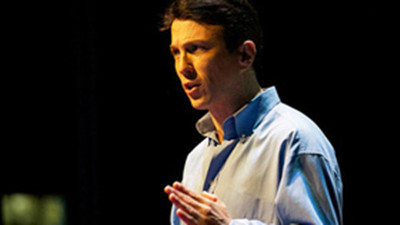Now if you have trouble maintaining your diet,it might help to have some extra imagery to remind you how many calories are going to be coming at you.
如果你不能保持節(jié)食,一些圖像也許會(huì)有助于提醒你食物里有多少熱量。
How about enabling the pathologist to use their cell phone again to see at a microscopic level and to lumber that data back to the cloud and make better diagnostics?
讓病理學(xué)家能用他們的手機(jī)在顯微水平觀察把數(shù)據(jù)放回云端信息來(lái)做更好的診斷會(huì)怎樣?
In fact, the whole era of laboratory medicine is completely changing.
實(shí)際上,整個(gè)實(shí)驗(yàn)醫(yī)學(xué)時(shí)代完全變了。
We can now leverage microfluidics,like this chip made by Steve Quake at Stanford.
我們能利用微流體,像斯坦福的Steve Quake公司制造的芯片。
Microfluidics can replace an entire lab of technicians.
微流體能替代整個(gè)實(shí)驗(yàn)室的技術(shù)員。
Put it on a chip, enable thousands of tests to be done at the point of care, anywhere in the world.
把它放在一個(gè)芯片上,能做幾千個(gè)測(cè)試在世界任何地方都可以做。
And this is really going to leverage technology to the rural and the under-served and enable what used to be thousand-dollar tests to be done at pennies and at the point of care.
這將真正地從技術(shù)上獲益,那些農(nóng)村和保障不發(fā)達(dá)地區(qū)能讓過(guò)去上千塊的測(cè)試減到幾分錢(qián)在護(hù)理方面上講。
If we go down the small pathway a little bit farther,we're entering the era of nanomedicine,the ability to make devices super small to the point where we can design red blood cells or microrobots that will monitor our blood system or immune system,or even those that might clear out the clots from our arteries.
如果在這條小路上走得稍微遠(yuǎn)一點(diǎn),我們將來(lái)到納米醫(yī)學(xué)時(shí)代,能將裝置做得超小小到我們可以設(shè)計(jì)血紅細(xì)胞或者微型機(jī)器人來(lái)監(jiān)測(cè)我們的血液系統(tǒng)或免疫系統(tǒng),或者甚至清除動(dòng)脈里的血栓。
Now how about exponentially cheaper?
如果指數(shù)更加便宜會(huì)怎樣?
Not something we usually think about in the era of medicine,but hard disks used to be 3,400 dollars for 10 megabytes-exponentially cheaper.
在醫(yī)學(xué)領(lǐng)域,這種便宜不是我們通常認(rèn)為的那樣,而是10MB硬盤(pán)過(guò)去3400美元-指數(shù)便宜。
In genomics now,the genome cost about a billion dollars about 10 years ago when the first one came out.
在基因組學(xué),基因組價(jià)值約10億美元10年前當(dāng)?shù)谝粋€(gè)基因組出現(xiàn)的時(shí)候。
We're now approaching essentially a thousand-dollar genome-probably next year to two years, probably a hundred-dollar genome.
我們現(xiàn)在基本上可以1000美元買(mǎi)到。也許今后一兩年,100美元的基因組會(huì)出現(xiàn)。
What are we going to do with hundred-dollar genomes?
我們能用100美元的基因組做什么呢?
And soon we'll have millions of these tests available.
不久以后我們可以進(jìn)行上百萬(wàn)的測(cè)試。
And that's when it gets interesting, when we start to crowdsource that information.
那就是當(dāng)它變得有趣的時(shí)候,當(dāng)我們開(kāi)始集中信息資源的時(shí)候。
And we enter the era of true personalized medicine,the right drug for the right person at the right time,instead of what we're doing today, which is the same drug for everybody,sort of blockbuster drug medications,medications which don't work for you, the individual.
我們進(jìn)入了真正的個(gè)人化醫(yī)學(xué)時(shí)代,在正確的時(shí)間為正確的人制造正確的藥,而不是像現(xiàn)在我們這樣,給每個(gè)人同樣的藥物,一種藥物治療的混亂,對(duì)你個(gè)人不一定有效。
And many, many different companies are working on leveraging these approaches.
很多不同的公司正在利用這些方法。
And I'll also show you a simple example, from 23andMe again.
我會(huì)給你一個(gè)簡(jiǎn)單的例子,還是來(lái)自23andMe。
My data indicates that I've got about average risk for developing macular degeneration, a kind of blindness.
我的數(shù)據(jù)表明我已經(jīng)達(dá)到平均風(fēng)險(xiǎn)系數(shù)對(duì)于黃斑病變,一種失明病。
But if I take that same data, upload it to deCODEme,I can look at my risk for sample type 2 diabetes.
但是如果我把同樣的數(shù)據(jù)上傳到deCODEme,比如我能看到我得2型糖尿病的風(fēng)險(xiǎn)指數(shù)。
I'm at almost twice the risk for type 2 diabetes.
我現(xiàn)在差不多有2倍的風(fēng)險(xiǎn)得2型糖尿病。
I might want to watch how much dessert I have at the lunch break for example.
例如我也許想看到午飯的時(shí)候吃多少甜點(diǎn)。
It might change my behavior.
這也許能改變我的行為。
Leveraging my knowledge of my pharmacogenomics,how my genes modulate, what my drugs do and what doses I need are going to become increasingly important,and once in the hands of the individual and the patient,will make better drug dosing and selection available.
利用我基因測(cè)試學(xué)的知識(shí),我的基因怎樣調(diào)整,我的藥物作用是什么和我需要什么將變得越來(lái)越重要,在個(gè)人和患者手中的時(shí)候,將使得可用的藥物選擇和服用更好。
So again, it's not just genes, it's multiple details our habits, our environmental exposure.
所以不僅是基因,有多種因素,我們的習(xí)慣,我們的環(huán)境。
When was the last time your physician asked you where you've lived?
上次醫(yī)生問(wèn)你住在哪里是什么時(shí)間?
Geomedicine: where you've lived, what you've been exposed to,can dramatically affect your health.
風(fēng)土醫(yī)學(xué):你住在哪里,你接觸過(guò)什么能極大影響你的健康。
We can capture that information.
我們能抓住這些信息。
So genomics, proteomics, the environment,all this data streaming at us individually and us, as poor physicians,how do we manage it?
因此基因組學(xué),蛋白組學(xué),環(huán)境,所有數(shù)據(jù)涌向我們作為個(gè)體人和醫(yī)生們。我們?cè)鯓庸芾硭鼈兡兀?/div>
Well we're now entering the era of systems medicine, or systems biology,where we can start to integrate all of this information.
我們正在進(jìn)入系統(tǒng)醫(yī)學(xué)或者系統(tǒng)生物學(xué)時(shí)代,我們能開(kāi)始集成這些信息。
And by looking at the patterns, for example, in our blood of 10,000 biomarkers in a single test,we can start to look at these little patterns and detect disease at a much earlier stage.
通過(guò)這些式樣,例如,在我們的血液中一個(gè)測(cè)試中有10000個(gè)生物標(biāo)記,我們能看這些小的式樣在非常早期發(fā)現(xiàn)疾病。
This has been called by Lee Hood, the father of the field,P4 medicine.
這個(gè)領(lǐng)域的創(chuàng)始人,李?胡德叫這種方法為P4醫(yī)學(xué)。
We're going to be predictive; we're going to know what you're likely to have.
我們將能預(yù)測(cè);我們能知道我們可能會(huì)怎樣。
We can be preventative; that prevention can be personalized;and more importantly, it's going to become increasingly participatory.
我們能預(yù)防;這種預(yù)防性可以個(gè)人化;更重要的是,它將變得共享。
Through websites like Patients Like Me or managing your data on Microsoft HealthVault or Google Health,leveraging this together in participatory ways is going to become increasingly important.
雖然一些網(wǎng)站像Patients Like Me,微軟HealthVault或者谷歌Health可以管理數(shù)據(jù),用共享的方式利用數(shù)據(jù)將變得越來(lái)越重要。
So I'll finish up with exponentially better.
我將以指數(shù)地更好前景來(lái)做結(jié)束。
We'd like to get therapies better and more effective.
我們會(huì)得到更好更有效的治療。
Now today we treat high blood pressure mostly with pills.
如今我們通常通過(guò)吃藥治療高血壓。
What if we take a new device and knock out the nerve vessels that help mediate blood pressure and in a single therapy to cure hypertension?
如果我們用一種新裝置敲打神經(jīng)血管幫助調(diào)節(jié)血壓一次治療就能治愈高血壓。
This is a new device that is essentially doing that.
這是做這種治療的一種新裝置。
It should be on the market within a year or two.
它應(yīng)該能在一兩年內(nèi)投放市場(chǎng)。

How about more targeted therapies for cancer?
更具目標(biāo)性的癌癥治療會(huì)怎樣呢?
Right, I'm an oncologist and I have to say most of what we give is actually poison.
對(duì),我是腫瘤學(xué)家,我不得不說(shuō)大多數(shù)我們開(kāi)的藥實(shí)際上是毒藥。
We've learned at Stanford and other places that we can discover cancer stem cells,the ones that seem to be really responsible for disease relapse.
我們?cè)谒固垢:推渌胤綄W(xué)到,我們可以發(fā)現(xiàn)癌癥干細(xì)胞,可能是癌癥復(fù)發(fā)的真正原因。
So if you think of cancer as a weed,we often can whack the weed away.
如果你把癌癥看作一個(gè)種子,我們通常能夠去除這個(gè)種子。
It seems to shrink, but it often comes back.
它好像萎縮了,但它經(jīng)常又重新復(fù)發(fā)。
So we're attacking the wrong target.
所以我們正在去除錯(cuò)誤的目標(biāo)體。
The cancer stem cells remain,and the tumor can return months or years later.
癌癥干細(xì)胞仍存在,腫瘤能在幾個(gè)月或幾年后重新長(zhǎng)出來(lái)。
We're now learning to identify the cancer stem cells and identify those as targets and go for the long-term cure.
我們現(xiàn)在學(xué)會(huì)了鑒定癌癥干細(xì)胞作為鑒定目標(biāo)體來(lái)進(jìn)行長(zhǎng)期治療。
And we're entering the era of personalized oncology,the ability to leverage all of this data together,analyze the tumor and come up with a real, specific cocktail for the individual patient.
我們正在進(jìn)入個(gè)人化腫瘤學(xué)時(shí)代,利用匯集所有數(shù)據(jù)的能力,分析腫瘤并提出來(lái)針對(duì)每一個(gè)患者而采用的一個(gè)真正的,明確的雞尾酒療法。
Now I'll close with regenerative medicine.
最后我會(huì)講講再生醫(yī)學(xué)。
So I've studied a lot about stem cells embryonic stem cells are particularly powerful.
我對(duì)干細(xì)胞研究很多,胚胎干細(xì)胞尤其強(qiáng)大。
We also have adult stem cells throughout our body.
我們有遍布我們身體的成體干細(xì)胞。



